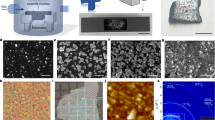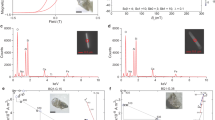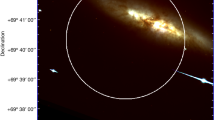Abstract
The elemental carbon-to-oxygen ratio (C/O) in the atmosphere of a giant planet is a promising diagnostic of that planet’s formation history in a protoplanetary disk. Alongside efforts in the exoplanet community to measure the C/O ratio in planetary atmospheres, observational and theoretical studies of disks are increasingly focused on understanding how the gas-phase C/O ratio varies both with radial location and between disks. This is mostly tied to the icelines of major volatile carriers such as CO and H2O. Using ALMA observations of CS and SO, we have found evidence for an entirely unexpected type of C/O variation in the protoplanetary disk around HD 100546: an azimuthal variation from a typical, oxygen-dominated ratio (C/O ≈ 0.5) to a carbon-dominated ratio (C/O ≳ 1.0). We show that the spatial distribution and peculiar line kinematics of both CS and SO molecules can be well explained by azimuthal variations in the C/O ratio. We propose a shadowing mechanism that could lead to such a chemical dichotomy. Our results imply that tracing the formation history of giant exoplanets using their atmospheric C/O ratios will need to take into account time-dependent azimuthal C/O variations in a planet’s accretion zone.
This is a preview of subscription content, access via your institution
Access options
Access Nature and 54 other Nature Portfolio journals
Get Nature+, our best-value online-access subscription
$29.99 / 30 days
cancel any time
Subscribe to this journal
Receive 12 digital issues and online access to articles
$119.00 per year
only $9.92 per issue
Buy this article
- Purchase on Springer Link
- Instant access to full article PDF
Prices may be subject to local taxes which are calculated during checkout






Similar content being viewed by others
Data availability
The data presented here are from the ALMA Cycle 4 programme 2016.1.01339.S (principal investigator M. Kama). The raw data are publicly available from the ALMA archive. The reduced data and final imaging products are available upon reasonable request from the corresponding author.
Code availability
The ALMA data were reduced using CASA version 5.6.1-8, which is available at https://casa.nrao.edu/. Outputs from the DALI physical-chemical disk models are available at https://doi.org/10.5281/zenodo.7734194.
Change history
04 May 2023
A Correction to this paper has been published: https://doi.org/10.1038/s41550-023-01984-0
References
Madhusudhan, N. C/O ratio as a dimension for characterizing exoplanetary atmopsheres. Astrophys. J. 758, 36 (2012).
Cridland, A. J., Pudritz, R. E. & Alessi, M. Composition of early planetary atmospheres—I. Connecting disc astrochemistry to the formation of planetary atmospheres. Mon. Not. R. Astron. Soc. 461, 3274–3295 (2016).
Mordasini, C., van Boekel, R., Molliè re, P., Henning, T. & Benneke, B. The imprint of exoplanet formation history on observable present-day spectra of hot Jupiters. Astrophys. J. 832, 41 (2016).
Oberg, K. I., Murray-Clay, R. & Bergin, E. A. The effects of snowlines on C/O in planetary atmospheres. Astrophys. J. Lett. 743, L16 (2011).
Madhusudhan, N., Knutson, H., Fortney, J. J. & Barman, T. in Protostars and Planets VI (eds Beuther, H. et al.) 739–762 (University of Arizona Press, 2014).
Bergin, E. A. et al. Hydrocarbon emission rings in protoplanetary disks induced by dust evolution. Astrophys. J. 831, 101 (2016).
Booth, R. A., Clarke, C. J., Madhusudhan, N. & Ilee, J. D. Chemical enrichment of giant planets and discs due to pebble drift. Mon. Not. R. Astron. Soc. 469, 3994–4011 (2017).
Krijt, S., Schwarz, K. R., Bergin, E. A. & Ciesla, F. J. Transport of CO in protoplanetary disks: consequences of pebble formation, settling, and radial drift. Astrophys. J. 864, 78 (2018).
Booth, R. A. & Ilee, J. D. Planet-forming material in a protoplanetary disc: the interplay between chemical evolution and pebble drift. Mon. Not. R. Astron. Soc. 487, 3998–4011 (2019).
Cridland, A. J., Eistrup, C. & van Dishoeck, E. F. Connecting planet formation and astrochemistry. Refractory carbon depletion leading to super-stellar C/O in giant planetary atmospheres. Astron. Astrophys. 627, A127 (2019).
van ’t Hoff, M. L. R., Bergin, E. A., Jørgensen, J. K. & Blake, G. A. Carbon-grain sublimation: a new top-down component of protostellar chemistry. Astrophys. J. 897, L38 (2020).
Bosman, A. D. et al. Molecules with ALMA at planet-forming scales (MAPS). VII. Substellar O/H and C/H and superstellar C/O in planet-feeding gas. Astrophys. J. Suppl. Ser. 257, 7 (2021).
Turrini, D. et al. Tracing the formation history of giant planets in protoplanetary disks with carbon, oxygen, nitrogen, and sulfur. Astrophys. J. 909, 40 (2021).
Van Clepper, E., Bergner, J., Bosman, A., Bergin, E. & Ciesla, F. Chemical feedback of pebble growth: impacts on CO depletion and C/O ratios. Astrophys. J. 927, 206 (2022).
Hobbs, R., Shorttle, O. & Madhusudhan, N. Molecular tracers of planet formation in the atmospheres of hot Jupiters. Mon. Not. R. Astron. Soc. 516, 1032–1046 (2022).
Favre, C., Cleeves, L. I., Bergin, E. A., Qi, C. & Blake, G. A. A significantly low CO abundance toward the TW Hya protoplanetary disk: a path to active carbon chemistry? Astrophys. J. Lett. 776, L38 (2013).
Qi, C. et al. Imaging of the CO snow line in a solar nebula analog. Science 341, 630–632 (2013).
van der Marel, N. et al. Resolved gas cavities in transitional disks inferred from CO isotopologs with ALMA. Astron. Astrophys. 585, A58 (2016).
Du, F. et al. Survey of cold water lines in protoplanetary disks: indications of systematic volatile depletion. Astrophys. J. 842, 98 (2017).
Cleeves, L. I. et al. Constraining gas-phase carbon, oxygen, and nitrogen in the IM lup protoplanetary disk. Astrophys. J. 865, 155 (2018).
Zhang, K., Bergin, E. A., Schwarz, K., Krijt, S. & Ciesla, F. Systematic variations of CO gas abundance with radius in gas-rich protoplanetary disks. Astrophys. J. 883, 98 (2019).
Zhang, K., Bosman, A. D. & Bergin, E. A. Excess C/H in protoplanetary disk gas from icy pebble drift across the CO snowline. Astrophys. J. Lett. 891, L16 (2020).
Miotello, A. et al. Bright C2H emission in protoplanetary discs in Lupus: high volatile C/O > 1 ratios. Astron. Astrophys. 631, A69 (2019).
Bergner, J. B. et al. A survey of C2H, HCN, and C18O in protoplanetary disks. Astrophys. J. 876, 25 (2019).
Semenov, D. et al. Chemistry in disks. Astron. Astrophys. 617, A28 (2018).
Booth, A. S., van der Marel, N., Leemker, M., van Dishoeck, E. F. & Ohashi, S. A major asymmetric ice trap in a planet-forming disk. Astron. Astrophys. 651, L6 (2021).
Dutrey, A. et al. Chemistry in disks. V. Sulfur-bearing molecules in the protoplanetary disks surrounding LkCa15, MWC480, DM Tauri, and GO Tauri. Astron. Astrophys. 535, A104 (2011).
Le Gal, R. et al. Molecules with ALMA at planet-forming scales (MAPS). XII. Inferring the C/O and S/H ratios in protoplanetary disks with sulfur molecules. Astrophys. J. Suppl. Ser. 257, 12 (2021).
Booth, A. S. et al. Sulphur monoxide emission tracing an embedded planet in the HD 100546 protoplanetary disk. Astron. Astrophys. 669, A53 (2023).
Arun, R. et al. On the mass accretion rate and infrared excess in Herbig Ae/Be stars. Astron. J. 157, 159 (2019).
Walsh, C. et al. ALMA hints at the presence of two companions in the disk around HD 100546. Astrophys. J. 791, L6 (2014).
Fedele, D., Toci, C., Maud, L. T. & Lodato, G. ALMA 870 μm continuum observations of HD 100546. Astron. Astrophys. 651, A90 (2021).
Quanz, S. P. et al. Confirmation and characterization of the protoplanet HD 100546 b—direct evidence for gas giant planet formation at 50 au. Astrophys. J. 807, 64 (2015).
Currie, T. et al. Resolving the HD 100546 protoplanetary system with the gemini planet imager: evidence for multiple forming, accreting planets. Astrophys. J. 814, L27 (2015).
Pinilla, P., Birnstiel, T. & Walsh, C. Sequential planet formation in the HD 100546 protoplanetary disk? Astron. Astrophys. 580, A105 (2015).
Walsh, C., Daley, C., Facchini, S. & Juhász, A. CO emission tracing a warp or radial flow within 100 au in the HD 100546 protoplanetary disk. Astron. Astrophys. 607, A114 (2017).
Bruderer, S., van Dishoeck, E. F., Doty, S. D. & Herczeg, G. J. The warm gas atmosphere of the HD 100546 disk seen by Herschel. Evidence of a gas-rich, carbon-poor atmosphere? Astron. Astrophys. 541, A91 (2012).
Bruderer, S. Survival of molecular gas in cavities of transition disks. I. CO. Astron. Astrophys. 559, A46 (2013).
Kama, M. et al. Volatile-carbon locking and release in protoplanetary disks. A study of TW Hya and HD 100546. Astron. Astrophys. 592, A83 (2016).
Pineda, J. E. et al. High-resolution ALMA observations of HD 100546: asymmetric circumstellar ring and circumplanetary disk upper limits. Astrophys. J. 871, 48 (2019).
Wichittanakom, C. et al. The accretion rates and mechanisms of Herbig Ae/Be stars. Mon. Not. R. Astron. Soc. 493, 234–249 (2020).
Pirovano, L. M. et al. H2O distribution in the disc of HD 100546 and HD 163296: the role of dust dynamics and planet–disc interaction. Astron. Astrophys. 665, A45 (2022).
van Dishoeck, E. F. et al. Water in star-forming regions: physics and chemistry from clouds to disks as probed by Herschel spectroscopy. Astron. Astrophys. 648, A24 (2021).
Francis, L. & van der Marel, N. Dust-depleted inner disks in a large sample of transition disks through long-baseline ALMA observations. Astrophys. J. 892, 111 (2020).
Lovelace, R. V. E., Li, H., Colgate, S. A. & Nelson, A. F. Rossby wave instability of Keplerian accretion disks. Astrophys. J. 513, 805–810 (1999).
Law, C. J. et al. Molecules with ALMA at planet-forming scales (MAPS). III. Characteristics of radial chemical substructures. Astrophys. J. Suppl. Ser. 257, 3 (2021).
Zhang, K. et al. Molecules with ALMA at planet-forming scales (MAPS). V. CO gas distributions. Astrophys. J. Suppl. Ser. 257, 5 (2021).
Guzmán, V. V. et al. Molecules with ALMA at planet-forming scales (MAPS). VI. Distribution of the small organics HCN, C2H, and H2CO. Astrophys. J. Suppl. Ser. 257, 6 (2021).
Alarcón, F. et al. Molecules with ALMA at planet-forming scales (MAPS). VIII. CO gap in AS 209—gas depletion or chemical processing? Astrophys. J. Suppl. Ser. 257, 8 (2021).
Ilee, J. D. et al. Molecules with ALMA at planet-forming scales (MAPS). IX. Distribution and properties of the large organic molecules HC3N, CH3CN, and c-C3H2. Astrophys. J. Suppl. Ser. 257, 9 (2021).
van der Marel, N., Booth, A. S., Leemker, M., van Dishoeck, E. F. & Ohashi, S. A major asymmetric ice trap in a planet-forming disk. I. Formaldehyde and methanol. Astron. Astrophys. 651, L5 (2021).
Panic, O. et al. Observations of warm molecular gas and kinematics in the disc around HD 100546. Astron. Astrophys. 519, A110 (2010).
Miley, J. M. et al. Asymmetric mid-plane gas in ALMA images of HD 100546. Mon. Not. R. Astron. Soc. 485, 739–752 (2019).
Fedele, D., Bruderer, S., van den Ancker, M. E. & Pascucci, I. On the asymmetry of the OH ro-vibrational lines in HD 100546. Astrophys. J. 800, 23 (2015).
Nealon, R., Pinte, C., Alexander, R., Mentiplay, D. & Dipierro, G. Scattered light shadows in warped protoplanetary discs. Mon. Not. R. Astron. Soc. 484, 4951–4962 (2019).
Young, A. K. et al. Chemical signatures of a warped protoplanetary disc. Mon. Not. R. Astron. Soc. 505, 4821–4837 (2021).
Garufi, A. et al. The SPHERE view of the planet-forming disk around HD 100546. Astron. Astrophys. 588, A8 (2016).
Follette, K. B. et al. Complex spiral structure in the HD 100546 transitional disk as revealed by GPI and MagAO. Astron. J. 153, 264 (2017).
Lazareff, B. et al. Structure of Herbig AeBe disks at the milliarcsecond scale. Astron. Astrophys. 599, A85 (2017).
Bohn, A. J. et al. Probing inner and outer disk misalignments in transition disks. Constraints from VLTI/GRAVITY and ALMA observations. Astron. Astrophys. 658, A183 (2022).
Brittain, S. D., Najita, J. R. & Carr, J. S. High-resolution near-infrared spectroscopy of HD 100546. IV. Orbiting companion disappears on schedule. Astrophys. J. 883, 37 (2019).
Sissa, E. et al. High-contrast study of the candidate planets and protoplanetary disk around HD 100546. Astron. Astrophys. 619, A160 (2018).
Pérez, S. et al. Long baseline observations of the HD 100546 protoplanetary disk with ALMA. Astrophys. J. 889, L24 (2020).
Zhu, Z., Stone, J. M., Rafikov, R. R. & Bai, X. Particle concentration at the planet induced gap edges and vortices I. Iinviscid three dimensional hydro disks. Astrophys. J. 785, 122 (2014).
Norfolk, B. et al. The origin of the Doppler-flip in HD 100546: a large scale spiral arm generated by an inner binary companion. Astrophys. J. Lett. 936, L4 (2022).
Wright, C. M. et al. Resolving structure of the disc around HD100546 at 7 mm with ATCA. Mon. Not. R. Astron. Soc. 453, 414–438 (2015).
Mendigutía, I. et al. The protoplanetary system HD 100546 in Hα polarized light from SPHERE/ZIMPOL. A bar-like structure across the disk gap? Astron. Astrophys. 608, A104 (2017).
Debes, J. H. et al. Chasing shadows: rotation of the azimuthal asymmetry in the TW Hya disk. Astrophys. J. 835, 205 (2017).
Loomis, R. A. et al. Detecting weak spectral lines in interferometric data through matched filtering. Astron. J. 155, 182 (2018).
Carney, M. T. et al. Increased H2CO production in the outer disk around HD 163296. Astron. Astrophys. 605, A21 (2017).
Booth, A. S. et al. Sulphur monoxide exposes a potential molecular disk wind from the planet-hosting disk around HD 100546. Astron. Astrophys. 611, A16 (2018).
Gaia Collaboration Gaia Data Release 2. Summary of the contents and survey properties. Astron. Astrophys. 616, A1 (2018).
Pickles, A. J. A stellar spectral flux library: 1150–25000 Å. Publ. Astron. Soc. Aust. 110, 863–878 (1998).
Woodall, J., Agúndez, M., Markwick-Kemper, A. J. & Millar, T. J. The UMIST database for astrochemistry 2006. Astron. Astrophys. 466, 1197–1204 (2007).
Cleeves, L. I., Bergin, E. A. & Harries, T. J. Indirect detection of forming protoplanets via chemical asymmetries in disks. Astrophys. J. 807, 2 (2015).
Acknowledgements
We acknowledge D. Fedele for sharing the ALMA 870 μm continuum data. L.K. acknowledges funding via a Science and Technology Facilities Council (STFC) studentship. E.F.v.D. is supported by A-ERC grant agreement no. 101019751 MOLDISK. M.N.D. acknowledges the Swiss National Science Foundation (SNSF) Ambizione grant no. 180079, the Center for Space and Habitability (CSH) Fellowship, and the IAU Gruber Foundation Fellowship. C.W. acknowledges financial support from the University of Leeds, the Science and Technology Facilities Council, and UK Research and Innovation (grant numbers ST/T000287/1 and MR/T040726/1).
Author information
Authors and Affiliations
Contributions
L.K. reduced the ACA CS data, ran the chemical models, performed analysis of both the data and models, and wrote the manuscript. M.K. contributed to the analysis of both the data and models, original research concepts and writing of the manuscript, and led the proposal for the ACA data. A.S.B. provided the ALMA SO data and contributed to the writing of the manuscript. E.A.B., L.I.C., E.F.v.D., M.N.D., K.F., J.R., O.S. and C.W. contributed to the writing of the manuscript.
Corresponding author
Ethics declarations
Competing interests
The authors declare no competing interests.
Peer review
Peer review information
Nature Astronomy thanks Zhaohuan Zhu, Rebecca Nealon and Alison Young for their contribution to the peer review of this work.
Additional information
Publisher’s note Springer Nature remains neutral with regard to jurisdictional claims in published maps and institutional affiliations.
Extended data
Extended Data Fig. 1 Abundance maps and contribution functions for the modelled CS and SO emission in HD 100546.
Each panel shows an abundance map overlaid with contours representing 25% and 75% line emission (white). Top row: CS 7-6 emission from the C/O=0.5 region (left) and C/O>1 region (right). Bottom row: SO 77 − 66 + 78 − 67 emission from the C/O=0.5 region (left) and C/O>1 region (right).
Extended Data Fig. 2 Effect of varying the high-C/O wedge size and position on the modelled spectra.
Top row: SO 77 − 66 + 78 − 67 (left) and CS 7-6 (right) spectra for variations in wedge size (θ), centered on position ϕ = 0. Bottom panel: SO 77 − 66 + 78 − 67 (left and CS 7-6 (right) spectra for variations in wedge position (ϕ), for a fixed angular size θ = 60∘.
Extended Data Fig. 3 Temperature and density maps for the baseline HD 100546 disk model (C/O=0.5).
Top left: Gas number density. Bottom left: Dust number density. Top right: Gas temperature. Bottom right: Dust temperature.
Supplementary information
Supplementary Information
Supplementary Figs. 1–4, Tables 1–4 and Discussions 1 and 2.
Rights and permissions
Springer Nature or its licensor (e.g. a society or other partner) holds exclusive rights to this article under a publishing agreement with the author(s) or other rightsholder(s); author self-archiving of the accepted manuscript version of this article is solely governed by the terms of such publishing agreement and applicable law.
About this article
Cite this article
Keyte, L., Kama, M., Booth, A.S. et al. Azimuthal C/O variations in a planet-forming disk. Nat Astron 7, 684–693 (2023). https://doi.org/10.1038/s41550-023-01951-9
Received:
Accepted:
Published:
Issue Date:
DOI: https://doi.org/10.1038/s41550-023-01951-9



